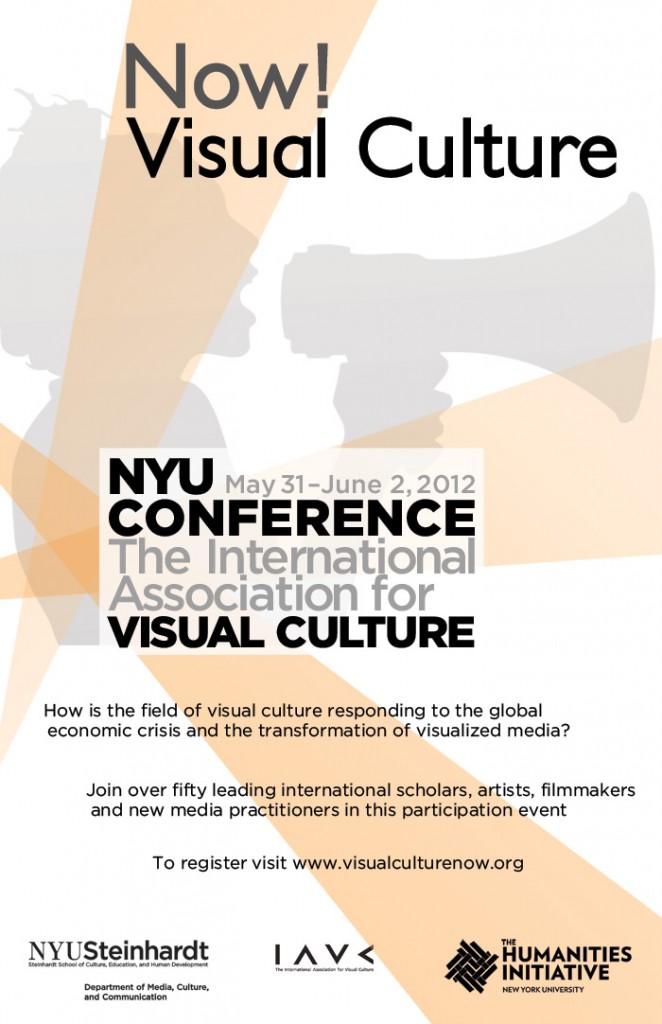Today was the opening of a conference that I helped convene in New York called Now! Visual Culture. It’s not an Occupy event as such but it takes place in the context of Occupy and many people attending are involved in the movement. It’s in my academic area, the anti-discipline of visual culture.
It turns out that we know a good deal about what visual culture is now. It’s a performative network, by which I mean a network created by the actions of those humans and non-humans within it. There are visual subjects and objects within a regime of visuality. The visual object, something that is looked at in all senses, has its own set of desires, powers and possibilities. The visual subject can be human, a person that looks or visualizes, or non-human, such as an Unmanned Aerial Vehicle or an imaging satellite. These latter devices are the agents of necropolitics, visualizing those who must die, even if a human takes the decision whether or not to fire on the visualized target– no visualization, no decision.
The interplay of visual subject and object takes place in a situation that is not of their choosing, which I call the regime of visuality. A given regime attempts to classify what there is to be seen and to separate those so classified into the groups that it creates, such as insurgents and host population; settlers and natives; black and white. At present, we can, as it were, see this regime. So when the police say to us, as they have so often in the past eight months, “move on, there’s nothing to see here,” we reply: “I would prefer not to.” It turns out, then, that visual culture has not become a discipline (with departments and so on) because it is foundationally anti-authoritarian.
And so we occupy, physically and mentally. In so doing, we find each other. We invent each other. We claim the right to look. We have now seen each other face to face, on livestream, on Twitter, on Facebook, on social media and in hearing the call of the other, in its murmuring, its casseroles, its chants. And now the question becomes, what should we do with that right to look?
We began to address that question today with 15 five minute presentations, or lightning talks, a format I borrowed from new media conferences. People from France, Norway, Mexico, Iraq, Nigeria, the UK, Canada, Hong Kong, Germany and the US presented. Presenters ranged from graduate students to professors, artists, and new media practitioners. They were more or less self-selected people who had asked to present. Yet four clear themes emerged
- Now: Occupy from the US to Canada and Nigeria
- Why: War, trauma and memory
- Where: Interfaces in digital and analog culture
- Here: Segregation and the (trans/post)national
I hate to single out any one moment but the image that stays with me in the context of this project was this extraordinary photograph taken in Lagos when the entire city of 14 million people rose up to Occupy Nigeria in protest against IMF/World Bank inspired gas price rises.
I had heard of Occupy Nigeria via Twitter but I had no idea what it had really been. Even Montreal seems “small” by comparison.
Unsurprisingly perhaps, the horizontalism that I first experienced at unconferences organized by hackers, and is now the process of Occupy, was well received by the people at the event. What was pleasantly surprising was the large turn-out, requiring people to stand and sit on the floor in the largest auditorium we have available. More exciting than that was the positive atmosphere, the sense of excitement that I have felt so missing in academic life. Perhaps, as horizontalism disseminates away from the sites of occupation into the disciplinary institutions it can work a form of internal revolution by anti-discipline.
More follows.


